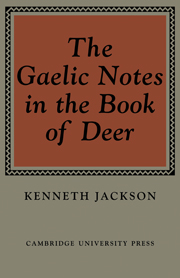Historical commentary
Published online by Cambridge University Press: 07 October 2011
Summary
PURPOSE, DATE AND GENUINENESS OF THE NOTES
What was the purpose of the Gaelic entries in the Book of Deer, and when were they written? Why should the monks wish to write up a record of the grants of land and immunities previously made to their monastery at the time they did, whenever that may have been?
In Anglo-Saxon England the writing of charters and other formal deeds, often granting land to religious bodies, in Latin or Anglo-Saxon, properly witnessed by clerical and lay notables, frequently dated, commonly detailing the boundaries of the lands granted, and sometimes invoking blessings on those who fulfil their provisions and curses on those who violate them, are a familiar feature. The earliest are as old as the late seventh century. Something of the same sort is found contemporaneously in Wales. There are several deeds written in the ninth and even late eighth centuries, in a mixture of Latin and Old Welsh, in the Book of St Chad, an eighth-century illuminated manuscript of the Gospels belonging at the time to one of the Welsh monasteries of St Teilo; and of the numerous mixed Latin and Old Welsh deeds in the mid twelfth-century Book of Llandaff, most appear to be copies or adaptations of older ones. An interesting example is the Chad document no. 4, of the ninth century, telling how a certain Ris and others (names illegible) gave a piece of land, whose boundaries and the dues to which it is subject are briefly described in Old Welsh.
- Type
- Chapter
- Information
- The Gaelic Notes in the Book of Deer , pp. 85 - 124Publisher: Cambridge University PressPrint publication year: 1972



